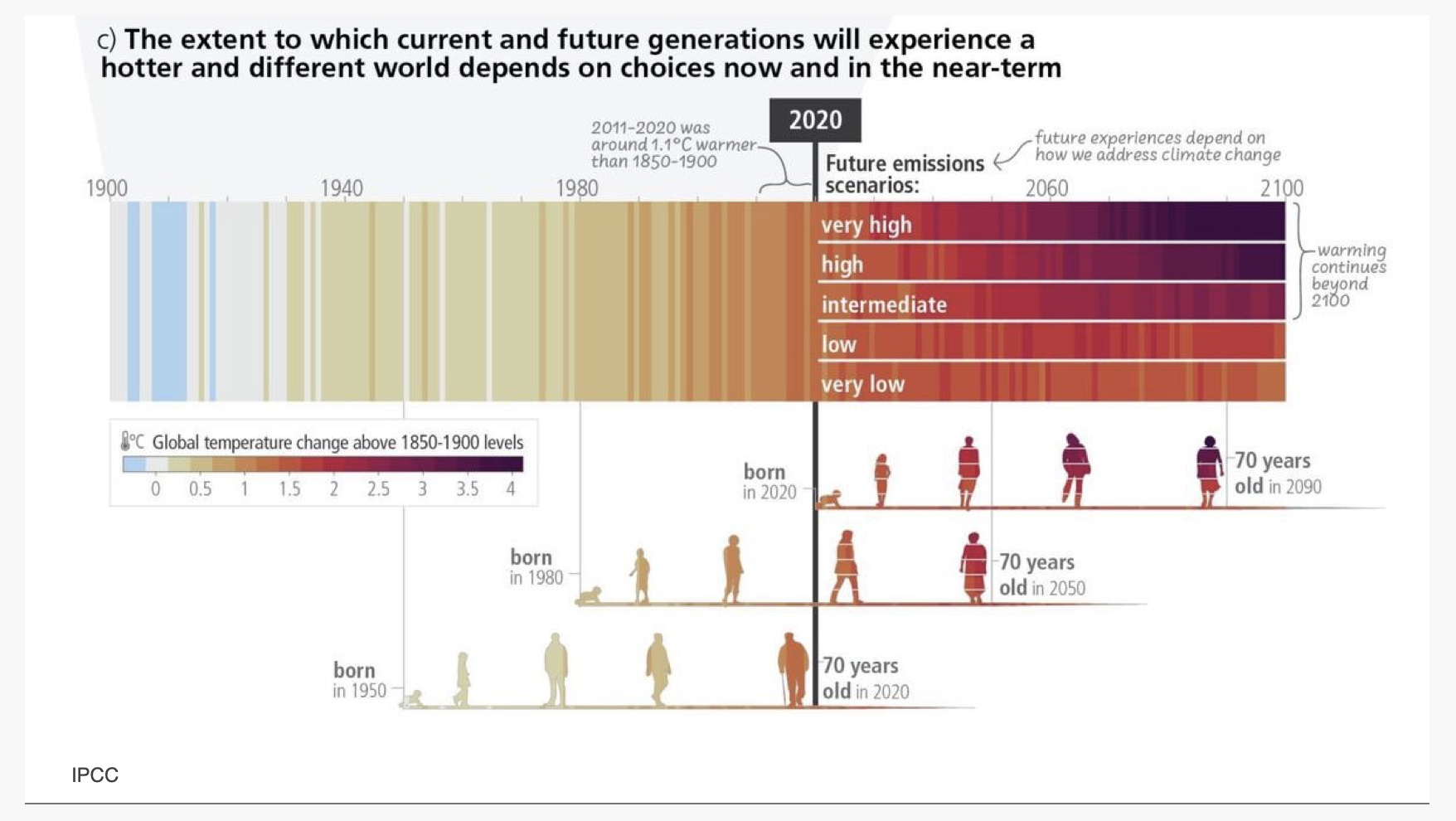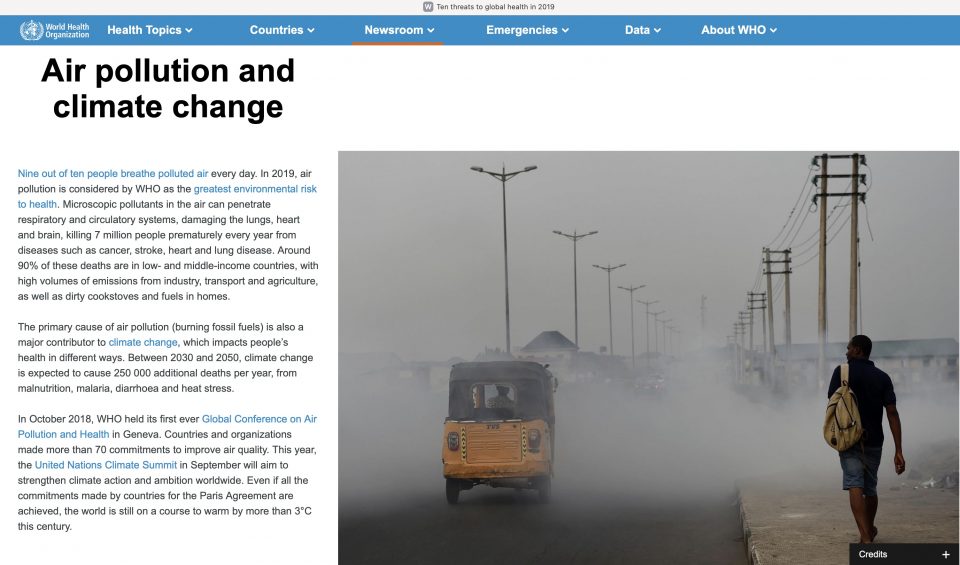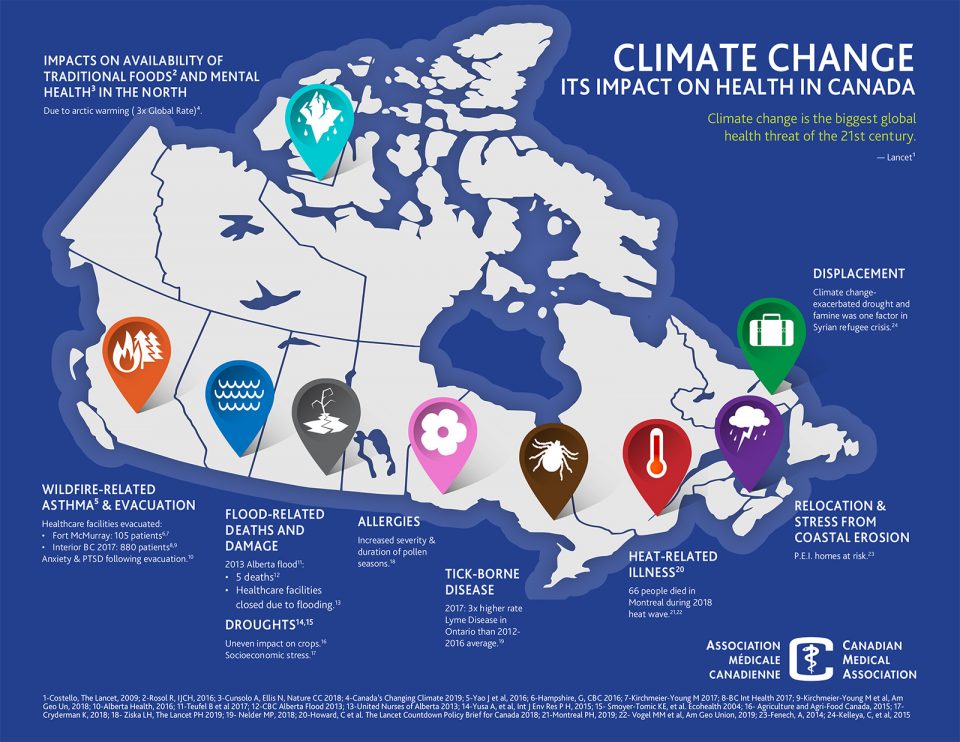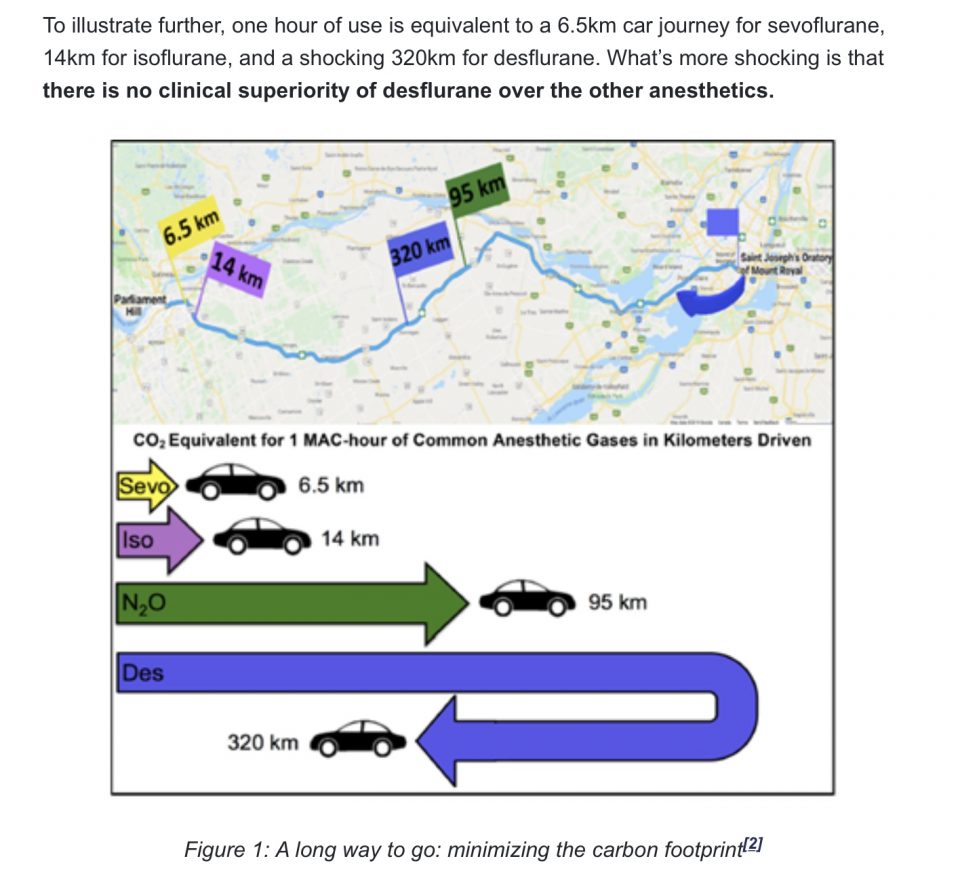With our shorter, milder winters (no skating on the Rideau Canal this past year), and our warmer, drier summers (thick wildfire smoke blanketing Ottawa in June), along with accelerating extreme weather events; derechos, ice storms and tornados – it is clear that climate change is not a future problem in faraway places. It is very much here and now. In fact, for a child born today, climate change may be the single greatest determinant of health over the course of their lifetime, which is why it is imperative that within healthcare we are more involved in this conversation.

This figure, a detail taken from Figure SPM.1 in the AR6 Synthesis Report by the Intergovernmental Panel on Climate Change, shows the observed and possible future average global temperature changes. (United Nations Intergovernmental Panel on Climate Change)
Paradoxically, there is a fairly jarring “urgency gap” between what science says we must do and what we are actually doing as a society.
While it is easy to fall prey to paralyzing climate doom, it is important to know that we can all play an active role in enacting climate solutions. This blog post aims to inform you about some direct health consequences of climate change that you will see in your practice and to give you concrete ideas of what you can do to help mitigate the worst effects of climate change.
Direct Health Impacts of Climate Change
Heat Waves
With global warming being the most salient feature of climate change, it is no surprise that there will be an increasing number of days of extreme heat and that heat waves will be more intense and prolonged. This will affect the most vulnerable members of our society, mostly older, poorer, and socially-isolated individuals who cannot afford air conditioning. Comorbid conditions and several medication classes can also increase the risks of heat-related illness. In June 2021, close to 650 people died in BC during the heat dome and it is estimated that over 61000 people died in Europe during the 2022 summer heat waves. We will definitely be seeing more patients with heat stress and heat stroke in the future.

This map depicts global temperature anomalies for meteorological summer in 2023 (June, July, and August). It shows how much warmer or cooler different regions of Earth were compared to the baseline average from 1951 to 1980. (Image credit: NASA Earth Observatory/Lauren Dauphin)
Air Pollution
The combustion of fossil fuels; from thermal coal plants to vehicles with internal combustion engines, leads to the production of PM2.5 that are very harmful to human health, increasing the risk of lung and heart disease, but also cancer, stroke and premature labour. The WHO considers air pollution to be the gravest environmental risk to health.
Forest Fires
There has been an increase in the frequency, intensity, and sizes of forest fires; witness the off-the-charts area burned in Canada this summer. These have immediate health consequences on affected populations (including burns and trauma as well as exacerbation of respiratory conditions) as well as delayed, long-lasting mental health consequences (like anxiety and PTSD) for evacuated populations as was seen following the Fort McMurray 2016 forest fire. This past summer, we have experienced how distant forest fires, fuelled by climate change, can have a dramatic and terrible effect on air quality that affected millions in eastern North America. Of course, patients with asthma and COPD are impacted much more immediately.
Vector-Borne Diseases
Spread of Ixodes ticks range is causing an increase in cases of Lyme disease, and this will worsen in the future. Ticks can transmit a number of other pathogens causing Babesiosis and Anaplasmosis and Powassan virus disease. We need to be more aware of these illnesses and increase our index of suspicion when confronted with febrile illnesses without a clear focus from the spring to early fall.
In the US, the range of Aedes aegypti, a mosquito vector of several arboviral diseases including Dengue fever, is expanding northward with the warming climate. These could eventually become established in Southern Canada. More immediately, there is predicted to be increased endemic mosquito-borne disease outbreaks like West Nile Virus due to climate-driven increased mosquito range and density.
Increase Surface Water Temperature
Increased surface water temperature will lead to an increased risk of food contamination and waterborne diseases such as Salmonella and Vibrio in seafood.
Climate change, in conjunction with global environmental degradation (deforestation, increased human-wildlife interaction), along with increased travel and human migration, has led to an acceleration in the pace of emerging infections. Just like Covid-19 spilled over from bats (naturally or accidentally) in Southwest China before going global, and just like MPOX took a plane from Nigeria before joining the party circuit in Europe and beyond, it is only a matter of time before another infectious pathogen emerges and causes another pandemic.
Extreme Weather
From flooding along the Ottawa River in 2017, to the prolonged power outage caused by the Derecho in May 2022 to the tornado in Barhaven in July 2023, accelerating extreme weather events can harm health directly (trauma) or indirectly (food insecurity due to loss of refrigerated food, heat stress from loss of AC) and cause mental health problems.
On the front of mental health, most young people are very concerned about the future climate they will inherit and this can lead to significant anxiety and depression. In fact, some new climate change-related psychiatric diagnoses are appearing such as eco-anxiety, pre-traumatic stress syndrome, and solastalgia, a form of existential distress where you don’t recognize the place where you live anymore because of environmental change.
Why Act
Of course, no single person is responsible for climate change and no single person can fix it alone. Yet we are all, collectively, actors and can make changes at the individual, family, and community level to nudge the system and contribute to the transformation of our society.
Just like during the pandemic, it was a collective, whole-of-society response that allowed us to “flatten the curve” back in 2020. We need an all-hands-on-deck effort to decrease our GHG emissions and to prevent the worst outcomes of runaway climate change.
Canadians have a particular responsibility as we have among the largest per capita carbon footprint at 14.2 tonnes CO2e/person/year. The government has stated that Canada must be carbon neutral by 2050 and we must all contribute to reach this goal.
As physicians, our role is even more important as we have a social responsibility toward our vulnerable patients, knowing full well all the negative impacts that climate change will have on their health. Furthermore, we have a professional duty to lead by example and, in doing so, to hopefully influence others and our political leaders to be bolder. Lastly, we are fortunate to have very good job security and to be in the top socioeconomic tranche so we can more easily afford to be early adopters of climate-friendly technologies that may have an up-front cost that could be prohibitive to a lower-income individual.
Here are a few things that you can do in your personal life and professional life that can have a positive impact – some can be enacted today, whereas others can be planned for this winter or scheduled for your next home renovation.
- Eat less meat: Beef has a huge carbon footprint, especially when compared to plant-based forms of protein. Eating less red meat is something you can do immediately to reduce your food-related GHG emissions. If this is new to you, try having a weekly meatless Mondays at first! And in general, try to eat a more plant-based diet most of the time. This is easy, and you’ll be healthier for it as well.

- Try plant-based milk substitute: Dairy farming has important GHG emissions in addition to extensive land use and water use. Oat milk is probably the best substitute in terms of its taste and green credentials. Try it out!
- Talking about food, try to minimize food waste, an important society-wide source of GHGs – so buy what you need and consume what you buy. Composting is great, but it best for food scraps, not whole foods that have gone bad.
- Divest your investments from fossil fuels stocks: Most physicians would consider it unethical to invest in tobacco or gun stocks, and the same can be said of investment in fossil fuel companies that are major contributors to climate change (and have spent the past several decades working to stall and block all attempts at an energy transition). Yes, they have been quite profitable with the energy crisis provoked by Russia’s invasion of Ukraine, but looking further ahead, their products (coal, oil, and gas) will be stranded assets in the coming net-zero carbon-neutral economy. The CMA has already divested several years ago, along with many other professional associations. Protect your investments by divesting from all fossil fuel assets. Talk to your financial advisor about this. If you invest with MD Management, they have an MD Fossil Fuel Free Equity Fund.
- Insulate your home: making your home more air-tight and better insulated will help to improve your home’s comfort and will make it more energy efficient – and will save you money on your monthly utility bill. This type of renovation can also be eligible for federal government rebates and incentives.
- Electrify everything! As a society, we need to move away from using fossil fuels for heating, cooking, and transportation. Luckily, there are excellent, more energy-efficient, and greener options that can allow you to have a net-zero home. The grid in Ontario is 92% zero-emissions and in Quebec it is 99%. This type of project can be done in stages during your next home renovation.
-
- In the kitchen, replace your gas range with an induction oven. “Natural gas” is a euphemism for methane and this fossil gas is a potent GHG when it leaks (and there are leaks throughout the production and transportation network) and it also releases toxic compounds and nitrogen dioxide when combusted. This is bad for your indoor air quality and particularly bad for children with respiratory conditions. Furthermore, an induction range is a much more efficient, much quicker way to cook and boil water.
- Replace your gas furnace with an air-sourced low-temperature heat pump. Space heating is one of the most important sources of residential GHG emissions, and these can be eliminated completely by heat pumps. Heat pumps are like AC units that can work both ways, transferring heat from your home to/from outside depending on whether you want to heat or cool your house. This technology has greatly improved in the past decade and they are a much more energy efficient way of heating or cooling your home.
- If you have a gas-powered water heater, replace it with an electrical hot water tank. By removing all gas use from your home, not only will you be reducing your emissions and air pollution, but you’ll also stop financing the fossil fuel company that sells you this methane gas.
- For your yard work, ditch the incredibly polluting and noisy gas-powered leaf blower and snowblower and buy cutting-edge, clean electric tools!
- Want to go big? Install solar panels on your south-facing roof. You can generate clean power on sunny days and get a credit on your electricity bill via the net-metering option. A more “techy” option is to install battery storage for your solar energy so that you can have backup power in the event of a power outage.
- Talking about electrifying everything, knowing that transportation is an important source of GHG emissions, strongly consider buying a battery electric vehicle (EV) when you need to replace your vehicle. Yes, active mobility is best but having a car can be necessary at times. And yes, there is some embodied carbon to produce the battery, but this is rapidly canceled out by regular use and, over the car’s lifetime, EVs have a markedly smaller carbon footprint. Zero emissions means better air quality for all as well. And it’s not just Tesla anymore – although their high-speed charging network for long road trips remains the standard, every vehicle maker is currently making the transition and there is now a wide range of EVs for every taste, including SUVs and pickup trucks! In fact, all new vehicles sold in Canada will be required by law to be zero-emissions vehicles by 2035. With a home charger, you leave with a “full tank” every morning. And the public charging infrastructure is developing very fast. Range anxiety will soon be a thing of the past. There is also a federal government rebate for the purchase of a new EV until 2025. You’ll never need to fill up your tank with gas ever again, yet another way to “move your money” away from fossil fuel companies.
- There are tons of rebates and incentives to do the above changes like the Canada Greener Home Grant. A good local resource for all these grants is Better Homes Ottawa. For EVs, there are also a number of incentives and rebates.
-
- Fly less. This one is tough as most of us enjoy jetting off and exploring the world, in addition to traveling for work or conferences. But airline travel contributes to up to 5% of global warming and a long-haul flight is by far the largest contributor to a person’s annual carbon footprint. Several initiatives have sought to shame people into forgoing flying for leisure. The UK-based Jump Initiative recommends limiting your flying to one short-haul flight every 3 years and one long-haul flight every 8 years.
What can I do at Work?
Unfortunately, for important and valid patient/provider safety reasons, healthcare work generates a very important volume of waste, much of which is not recyclable or reusable. In Canada, the healthcare sector is responsible for up to 5% of GHG emissions.
Getting rid of examination table paper: If your ED or your clinic still uses paper on examination tables, know that is serves no purpose other than being a facsimile of cleanliness. Most patients dislike its crinkly feel and it is wasteful as it gets thrown out after one use. Get rid of it and simply disinfect the used surface with a disinfectant wipe.
Puffers: Do not prescribe any more pMDI puffers to your discharged patients. The contain planet-warming HFAs – use of a single pMDI puffer generates roughly the CO2 equivalent to driving 300 km in a car – and it is a cruel irony that these puffers are responsible for worsening climate change that will impact individuals with lung disease the most. There are excellent non-pMDI options for every type of inhaler and most Respirologists have already moved away from pMDI inhalers toward DPI and SMI inhalers. These new puffers have the added advantage that they do not require plastic aerochambers spacer devices.
Anesthetic gases: Avoid using nitrous oxide (laughing gas) for procedural sedation as this powerful GHG is simply vented off into the atmosphere. Similarly, talk to your use Anesthesia colleagues about phasing out the use of desflurane in the OR as it is markedly worse in terms of GHG potential than other common anesthetic gases such as isoflurane or sevoflurane. In an ideal world, most non-urgent OR cases would be done using neuraxial or regional anesthesia or under total intravenous anesthesia (TIVA) obviating the need for any anesthetic gases that are all vented off into the atmosphere.
Hospital-wide systems are certainly tougher to change but it might be worthwhile to talk to leadership to see if anything can be done to improve energy efficiency, local electricity generation with solar panels on the roof, increased recycling of hospital-generated waste, green roofs or roofs painted in a reflective paint to minimize the heat island effect, moving away from diesel-generator backup systems to battery storage.
Advocacy: Consider joining CAPE or make donations to the environmental charity of your choice, such as EcoJustice or the Sierra Club Canada or the David Suzuki Foundation for example.
Conclusions
According to IPCC, if we are to have any hope of avoiding the worse effects of runaway climate change, we need to halve our GHG emissions by 2030. Of course, governments and corporations must do much more to address climate change, but we also have a role as individuals – our lifestyle choices and consumption patterns have an important impact on our personal carbon footprint. We have direct control over our own personal GHG emissions and we all have to pitch in! Luckily, we currently have all the tools and technology we need to transition to a low-carbon lifestyle – all we now need is to act, together and quickly.
As Emergency Physicians, we are on the front line, yet again, of this crisis and will see first-hand the direct impacts of climate change on the health of our patients. It is our duty to act and to lead by example, to try to influence our family and our peers, and to advocate for change. And by taking action, we can have agency and create momentum in the hope of a better future for all.




